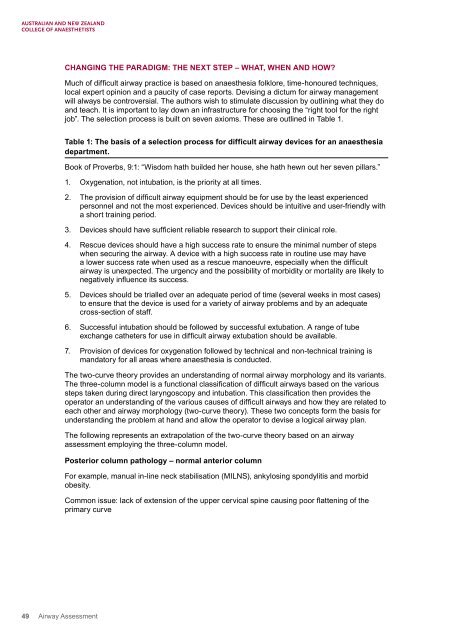Airway Assessment
2cKbSEQ
2cKbSEQ
You also want an ePaper? Increase the reach of your titles
YUMPU automatically turns print PDFs into web optimized ePapers that Google loves.
CHANGING THE PARADIGM: THE NEXT STEP – WHAT, WHEN AND HOW?<br />
Much of difficult airway practice is based on anaesthesia folklore, time-honoured techniques,<br />
local expert opinion and a paucity of case reports. Devising a dictum for airway management<br />
will always be controversial. The authors wish to stimulate discussion by outlining what they do<br />
and teach. It is important to lay down an infrastructure for choosing the “right tool for the right<br />
job”. The selection process is built on seven axioms. These are outlined in Table 1.<br />
Table 1: The basis of a selection process for difficult airway devices for an anaesthesia<br />
department.<br />
Book of Proverbs, 9:1: “Wisdom hath builded her house, she hath hewn out her seven pillars.”<br />
1. Oxygenation, not intubation, is the priority at all times.<br />
2. The provision of difficult airway equipment should be for use by the least experienced<br />
personnel and not the most experienced. Devices should be intuitive and user-friendly with<br />
a short training period.<br />
3. Devices should have sufficient reliable research to support their clinical role.<br />
4. Rescue devices should have a high success rate to ensure the minimal number of steps<br />
when securing the airway. A device with a high success rate in routine use may have<br />
a lower success rate when used as a rescue manoeuvre, especially when the difficult<br />
airway is unexpected. The urgency and the possibility of morbidity or mortality are likely to<br />
negatively influence its success.<br />
5. Devices should be trialled over an adequate period of time (several weeks in most cases)<br />
to ensure that the device is used for a variety of airway problems and by an adequate<br />
cross-section of staff.<br />
6. Successful intubation should be followed by successful extubation. A range of tube<br />
exchange catheters for use in difficult airway extubation should be available.<br />
7. Provision of devices for oxygenation followed by technical and non-technical training is<br />
mandatory for all areas where anaesthesia is conducted.<br />
The two-curve theory provides an understanding of normal airway morphology and its variants.<br />
The three-column model is a functional classification of difficult airways based on the various<br />
steps taken during direct laryngoscopy and intubation. This classification then provides the<br />
operator an understanding of the various causes of difficult airways and how they are related to<br />
each other and airway morphology (two-curve theory). These two concepts form the basis for<br />
understanding the problem at hand and allow the operator to devise a logical airway plan.<br />
The following represents an extrapolation of the two-curve theory based on an airway<br />
assessment employing the three-column model.<br />
Posterior column pathology – normal anterior column<br />
For example, manual in-line neck stabilisation (MILNS), ankylosing spondylitis and morbid<br />
obesity.<br />
Common issue: lack of extension of the upper cervical spine causing poor flattening of the<br />
primary curve<br />
49 <strong>Airway</strong> <strong>Assessment</strong>


